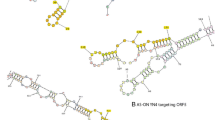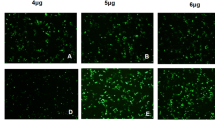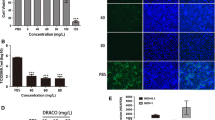Abstract
A robust artificial microRNA (amiRNA) strategy against porcine reproductive and respiratory syndrome virus (PRRSV) was developed by targeting the untranslated regions (UTRs). Six candidate amiRNAs targeting the 5′ or 3′ UTR were used for vector construction, and four effective amiRNAs were selected for further study using a vector transfection/virus infection assay. In cell cultures stably transfected with the four amiRNA vectors, expression of the sequence-specific amiRNAs was confirmed using poly(A)-tailed RT-PCR. After infection with three different PRRSV strains, the viral RNA genome and/or transcript were inhibited by ~90 % (semi-quantitative RT-PCR), and the viral titers were decreased by more than six log CCID50 (viral titration assay) before day 3 postinfection. The potent anti-PRRSV effects lasted for at least 5 days. Sequence analysis showed that the amiRNA antiviral activities were not compromised by the presence of one or two mismatches in their binding targets. This work constitutes a step towards developing a more effective RNAi strategy against PRRSV.






Similar content being viewed by others
References
Pejsak Z, Stadejek T, Markowska-Daniel I (1997) Clinical signs and economic losses caused by porcine reproductive and respiratory syndrome virus in a large breeding farm. Vet Microbiol 55:317–322
Neumann EJ, Kliebenstein JB, Johnson CD, Mabry JW, Bush EJ, Seitzinger AH, Green AL, Zimmerman JJ (2005) Assessment of the economic impact of porcine reproductive and respiratory syndrome on swine production in the United States. J Am Vet Med Assoc 227:385–392
Zhou L, Yang HC (2010) Porcine reproductive and respiratory syndrome in China. Virus Res 154:31–37
Done SH, Paton DJ (1995) Porcine reproductive and respiratory syndrome: clinical disease, pathology and immunosuppression. Vet Rec 136:32–35
Snijder EJ, Meulenberg JJ (1998) The molecular biology of arteriviruses. J Gen Virol 79:961–979
Dokland T (2010) The structural biology of PRRSV. Virus Res 154:86–97
Kimman TG, Cornelissen LA, Moormann RJ, Rebel JM, Stockhofe-Zurwieden N (2009) Challenges for porcine reproductive and respiratory syndrome virus (PRRSV) vaccinology. Vaccine 27(28):3704–3718
Nielson CJ, Murtaugh MP, Faaberg KS (1999) Porcine reproductive and respiratory syndrome virus comparison: divergent evolution on two continents. J Virol 7:270–280
Meng XJ (2000) Heterogeneity of porcine reproductive and respiratory syndrome virus: implications for current vaccine efficacy and future vaccine development. Vet Microbiol 74:309–329
Murtaugh MP, Stadejek T, Abrahante JE, Lam TT, Leung FC (2010) The ever-expanding diversity of porcine reproductive and respiratory syndrome virus. Virus Res 154(1–2):18–30
Sun Z, Liu C, Tan F, Gao F, Liu P, Qin A, Yuan S (2010) Identification of dispensable nucleotide sequence in 3′ untranslated region of porcine reproductive and respiratory syndrome virus. Virus Res 154(1–2):38–47
Gao F, Lu J, Yao H, Wei Z, Yang Q, Yuan S (2012) Cis-acting structural element in 5′ UTR is essential for infectivity of porcine reproductive and respiratory syndrome virus. Virus Res 163(1):108–109
Fire A (1999) RNA triggered gene silencing. TIG 15:358–363
Zhou J, Rossi JJ (2011) Progress in RNAi-based antiviral therapeutics. Methods Mol Biol 721:67–75
Terasawa K, Shimizu K, Tsujimoto G (2011) Synthetic pre-miRNA-based shRNA as potent RNAi triggers. J Nucleic Acids 2011:1–6
He YX, Hua RH, Zhou YJ, Qiu HJ, Tong GZ (2007) Interference of porcine reproductive and respiratory syndrome virus replication on MARC-145 cells using DNA-based short interfering RNAs. Antiviral Res 74(2):83–91
Li G, Jiang P, Li Y, Wang X, Huang J, Bai J, Cao J, Wu B, Chen N, Zeshan B (2009) Inhibition of porcine reproductive and respiratory syndrome virus replication by adenovirus-mediated RNA interference both in porcine alveolar macrophages and swine. Antiviral Res 82(3):157–165
Bao Y, Guo Y, Zhang L, Zhao Z, Li N (2012) Inhibition of porcine reproductive and respiratory syndrome virus replication by RNA interference in MARC-145 cells. Mol Biol Rep 39(3):2515–2522
Boden D, Pusch O, Silbermann R, Lee F, Tucker L, Ramratnam B (2004) Enhanced gene silencing of HIV-1 specific siRNA using microRNA designed hairpins. Nucleic Acids Res 32:1154–1158
Liu YP, Haasnoot J, ter Brake O, Berkhout B, Konstantinova P (2008) Inhibition of HIV-1 by multiple siRNAs expressed from a single microRNA polycistron. Nucleic Acids Res 36:2811–2824
Xiao S, Wang Q, Gao J, Wang L, He Z, Mo D, Liu X, Chen Y (2011) Inhibition of highly pathogenic PRRSV replication in MARC-145 cells by artificial microRNAs. Virol J 8:491
Collins JE, Benfield DA, Christianson WT, Harris L, Hennings JC, Shaw DP, Goyal SM, McCullough S, Morrison RB, Joo HS et al (1992) Isolation of swine infertility and respiratory syndrome virus (isolate ATCC VR-2332) in North America and experimental reproduction of the disease in gnotobiotic pigs. J Vet Diagn Invest 4:117–126
Hu SP, Zhang Z, Cai XH, Tian ZJ, An TQ, Wu DL (2009) Valuation of protective efficacy of PRRS attenuated vaccine and inactivated mutant PRRSV strains. Chin J Prev Vet Med 31:392–396
Tian K, Yu X, Zhao T, Feng Y, Cao Z, Wang C, Hu Y, Chen X, Hu D, Tain X et al (2007) Emergence of fatal PRRSV variants: unparalleled outbreaks of atypical PRRS in China and molecular dissection of the unique hallmark. PLoS One 2(6):e526
Durocher Y, Perret S, Kamen A (2002) High-level and high-throughput recombinant protein production by transient transfection of suspension-growing human 293-EBNA1 cells. Nucleic Acids Res 30(2):e9
Jacobs AC, Hermann JR, Munoz-Zanzi C, Prickett JR, Roof MB, Yoon KJ (2010) Stability of porcine reproductive and respiratory syndrome virus at ambient temperatures. J Vet Diagn Invest 22:257–260
Acknowledgments
This work was supported by the grant from the Ministry of Agriculture of China (2009ZX08010-019B), the Priority Academic Program Development (PAPD) of Jiangsu Higher Education Institutions, and the Program for Changjiang Scholars and Innovative Research Team in University (IRT0978).
Author information
Authors and Affiliations
Corresponding author
Rights and permissions
About this article
Cite this article
Xia, B., Song, H., Chen, Y. et al. Efficient inhibition of porcine reproductive and respiratory syndrome virus replication by artificial microRNAs targeting the untranslated regions. Arch Virol 158, 55–61 (2013). https://doi.org/10.1007/s00705-012-1455-z
Received:
Accepted:
Published:
Issue Date:
DOI: https://doi.org/10.1007/s00705-012-1455-z




